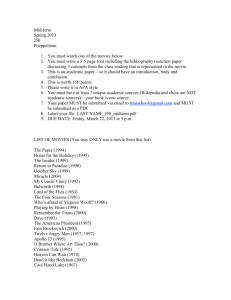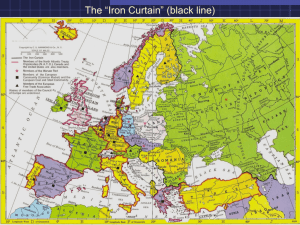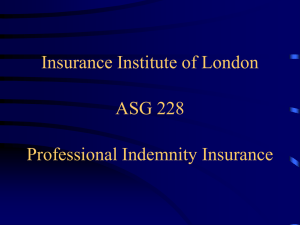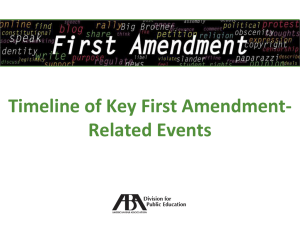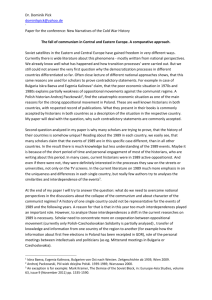Revolutionsof1989
advertisement
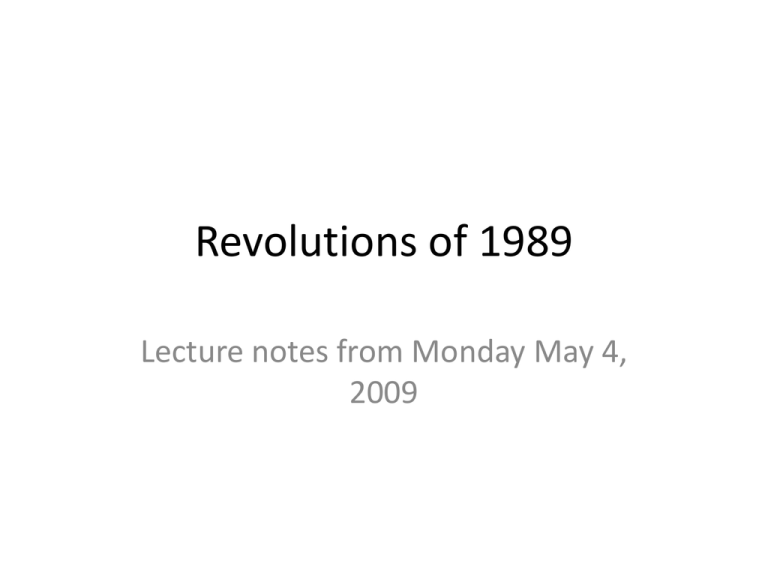
Revolutions of 1989 Lecture notes from Monday May 4, 2009 On-line sources and video • • • • • • Negotiating Radical Change :: Polish Round Table Talks Making the History of 1989 Cold War International History Project's Cold War Files Secrets from behind the (Crumbling) Iron Curtain YouTube - Romanian Revolution of 1989 YouTube - Berlin wall fall @ Potsdamer Platz 1989 in Berlin • BBC NEWS | Special Reports | 24 Nov: Velvet Revolution Event timeline and commentary on the construction of memory in a post-1989 united EUrope • BBC NEWS | Europe | 1989: Key events in Europe's revolution (note how this title ‘appropriates’ the revolutions for all of Europe even though they were carried out by east Europeans) • Eurozine - The revolutions of 1989 revisited - Stefan Auer • Eurozine - Balancing the books - Timothy Snyder • Eurozine - Battlefield Europe - Claus Leggewie Transnational memory and European identity • Eurozine - European histories • Eurozine - Places and strata of memory - Karl Schlögel Approaches to eastern Europe Poland: Roundtable and June Elections Hungary and the Reburial of Imre Nagy The Fall of the Berlin Wall The Velvet Revolution: Havel and Dubcek; Havel addressing the crowds Lecture Overview • What happened in 1989? • Why did it happen? Specifically, why did it happen the way it did? • What are the effects of 1989 for eastern Europe? Specifically, in terms of post-1989 political institutions and political culture. • What are the effects of 1989 for Europe as a whole? Can the revolutions serve as a basis for a common European identity; a shared European history? What happened in 1989: shared features • East European communist regimes placed under pressure from above (with Gorbachev’s reforms and his removal of the Soviet security guarantee for these regimes) and from below as popular pressure, either demonstrated or incipient, mounted in the face of growing economic troubles across the region. • Generational shift both in the Party and among the population brought into place a younger generation raised since Stalinism, consequently less fearful and more open to change. Almost all Parties (with the possible exception of the Czech CP) internally divided between young reformers and older ‘hard-liners.’ • Nonetheless, uncertainty prevailed as to how the hardliners would respond to the dual pressures they faced. Would they use violence to remain in power? Violence was used against the first wave of demonstrations in Prague and in the GDR; Gorbachev as well sent tanks to crush (literally) the peaceful demonstrators in Vilnius. Shared features, cont. • Remarkably, with the exception of Romania, all demonstrations remained committed to non-violence. In part due perhaps to the example set by Solidarity and in part due to the growing influence of the churches (Catholic in Czechoslovakia; Protestant in the GDR) in inspiring the mass demonstrations. • Remarkably, as well all transitions (again with the exception of Romania) were managed via Roundtable negotiations between regime and opposition – Poland with the longest negotiations, the CSSR with the shortest. These negotiations established the foundations of the new political systems, putting into place the institutional architecture (e.g. the powers of the presidency), the electoral laws and the establishment of multi-party systems Shared features, cont. • In terms of political trajectories, the opposition movements in Poland, Hungary, the GDR and the CSSR all experienced a rapid rise in power and influence, but then an almost equally rapid collapse of dissident led political coalitions that then fragmented into multiple political parties. • Simultaneously, the Communist Parties experienced a dramatic fall from power and collapse of membership but then went on to reconstitute themselves rapidly into reformed social democratic parties along west European lines (with the exception of the CP of the Czech Republic which has remained unreformed but still manages to get between 10-13% of the vote). Poland: what happened? Key features of the Polish transition: 1. As the first country to test the limits of Soviet tolerance for change in Eastern Europe, events in Poland take place in the context of considerable uncertainty and anxiety over far reform could go. 2. At the same time, social + economic conditions have gotten so bad, as demonstrated in the strike waves of 1988, that substantial reform is vital in order to avoid a descent into anomic social violence and/or violent resistance along the lines of the insurgencies in Ireland against British rule. 3. The absolute centrality of Jaruzelski and Walesa in moving both sides to the Roundtable and then guaranteeing the negotiated outcomes against hardliners in both camps. 4. While Polish communism is rapidly marginalized after the June elections, Party members shamelessly plunder the economy (Rothschild, p. 184) which has led to conspiracy theories prevalent in Poland to this day, that Walesa and his intellectual advisors secretly agreed to this at the Roundtable negotiations. 5. A particularly dramatic break-up of Solidarity dictated initially by Walesa but then deepened when Solidarity intellectuals refused to support his candidacy for the presidency in 1990, supporting instead their own candidate, PM Mazowiecki. Poland Key Elections • June 1989 Bicameral Parliamentary Elections -- 65% of seats in the lower house, the Sejm, reserved for the CP and its allied parties (that promptly defected from the CP after the elections) -- 100% of seats in the Senate open to contestation -- 2 Houses jointly to elect the President (clearly understood that this was to be Jaruzelski) After Solidarity’s dramatic victory, they end up forming the government under PM Mazowiecki but with 3 key ministries retained by the Communists (e.g., Defense and Interior) and with Jaruzelski elected President. November 1990 Presidential Elections Nov. 25 – 40% Walesa; 18% Mazowiecki; 23% Tyminski (a shady entrepreneur who flew in from Peru to run for the office) – 40% abstaining Dec. 9 run-off election – 74.25% Walesa; 25.75% Tyminski * These elections send cautionary signals regarding Poland’s post communist democracy – high levels of voter apathy and political party volatility (since almost anyone, like Tyminski, can become a viable candidate which thereby encourages the tendency to form new parties around specific individuals rather than consolidate parties around political programs or party platfroms. Hungary: what happened? Key features of the Hungarian transition: 1. Power struggles within the Hungarian Communist Party pave the way for reform, especially the “intra-party coup” in May 1988 which removes Kadar from power. Hungarian Communist Party among the first in the region to split when liberal reformist members form a social democratic party (that is currently in power having won the last two parliamentary elections) 2. Centrality of the legacies of the 1956 Hungarian Revolution – pushing both the Party and the opposition to moderate their positions and negotiate in good faith in order to prevent another such explosion of popular resistance; the reburial of Imre Nagy in July 1989 providing a catharsis but also a reminder of the population’s capacity to demonstrate on behalf of national freedom. 3. While the Hungarian Roundtable was long and complicated (June –September 1989), its results were immediately challenged by members of the opposition and hence key provisions (e.g. direct v. parliamentary election of the president) had to go to a public referendum. The Roundtable therefore does not serve as the basis for conspiracy theories. Instead, the extent to which the reformed CP, now Social Democrats, have been successful electorally has led to a strengthening of the nationalist opposition which consistently links the ‘new’ SD’s to the Communists who perpetrated such violence against the Hungarian people. East Germany (GDR): what happened Key features of the East German transition: 1. Here Gorbachev’s role in inspiring the opposition and in pulling the rug out from under the hardline regime is most evident. Elsewhere, he establishes the context in which events take place but does not determine the modalities or rhythms of protest. In East Germany however his state visit in Oct. 1989 led to mass demonstrations in Dresden and Berlin (“Gorby save us” read the homemade placards) 2. The mass exodus of East Germans to the west (West Germany guaranteed them citizenship status and financial aid) through Hungary in the late summer and fall placed pressure on the regime to liberalize its travel laws which led to the late night announcement on Nov. 9 of the new provisions which in turn led, unintentionally, to the fall of the wall as thousands turned out to test the new law. 3. Given the country’s status as an artificial entity (a product of WWII and the division of Germany into zones of occupation), once the East German population demanded reunification (changing their protest slogans from “We are the people” to “We are one people”), the dissolution of East Germany became all but inevitable. With re-unification, scholarship on eastern Europe no longer includes developments in east Germany as a comparative case which is unfortunate because the region arguably shares more with its neighbours to the east than with west Germany. East Germany, cont. Key questions in the East German case: 1. How did so many protest peacefully after so many years of repression and with so little organized resistance to communist rule? The numbers: Oct. 7 – 30,000 in Dresden; Oct. 9 – 70,000 to 100,000 in Leipzig; Nov. 4 – 1 million in Berlin. Why so many? According to a survey taken in Leipzig in the fall of 1990, protesters explained their participation in terms of greater perceived opportunity to exercise political influence and in terms of friendship networks that encouraged protest attendance. Here the social context appears crucially to have shifted from the extensive social monitoring that supported the repressive regime to peer pressure facilitating resistance. Why so peaceful? Possibly because most demonstrations began with a Church sponsored event, a mass or candle light vigil, and because speakers consistently addressed the need for non-violent civil disobedience. East Germany, cont. 2. Why did the regime give in so quickly and not use force in self-preservation after initially using violence against protesters in early October 1989? Here, reform minded CP leaders like Egon Krenz (who took over from hardliner Honecker on Oct. 17), apparently in conjunction with moderate local CP officials and public figures like the conductor Kurt Mazur, successfully promoted peaceful solutions both on humanitarian grounds and in the fear of what massive reprisals against peaceful demonstrators would do to the regime’s international standing. Given the regime’s extensive indebtedness to the West, any disruption in the flow of credits would be devastating to an already fragile economy. Czechoslovakia: what happened? Key features of the Czech transition: 1. After years of stagnation and post 1968 ‘normalization’, the most dramatic regime collapse: Nov. 17 students hold a demonstration on the 50th anniversary of the death of Jan Opletal killed by the Nazis (ca. 50,000 with extensive regime force used against demonstrators); Nov. 25 750,000 demonstrate in Prague; Nov. 27 general strike; Dec. 3 hardliners removed from the regime; Dec. 28 Dubcek is returned to power as Chairman of the Federal Assembly; Dec. 29 Havel is made President. 2. Why so rapid a collapse? Significant preconditions: economic stagnation (Aug 1989, economist Milos Zeman announces on TV that the economy is in deep trouble) and ecological devastation becoming more evident to the general population; the growth of opposition beyond the limited circles of intellectuals in Charter 77 and VONS to include increasing numbers of students, workers and Catholics; Gorbachev effectively destabilizing the CP by withdrawing the Soviet security guarantee and not interfering in Czechoslovak internal matters. 3. After the “Velvet Revolution,” the “Velvet Divorce” rapidly follows as the Czech and Slovak leadership fail to reach agreement on the appropriate institutional architecture for the federal state. The well managed divorce nonetheless is a testimony to their diplomatic abilities. Romania: what happened? Key features of the Romanian “coup d’etat”: 1. Under the leadership of Ceausescu, Romania experienced a brutal Stalinist style dictatorship which nonetheless enjoyed Western support for Ceausescu’s anti-Soviet foreign policy, having withdrawn Romania from the Warsaw Pact in 1966. Romania’s long period of Stalinist rule included a cult of the family as Ceausescu glorified himself, his wife and children, periodic purges of the party, the absolute ‘subjugation of society’ under the region’s most repressive secret police, the infamous Securitate, and economic conditions so dire that society has to endure a “neo-surfdom” as workers are forcibly tied to their positions. 2. Under such repressive conditions and given the regime’s long-standing autonomy from the SU (meaning that Gorbachev’s reform initiatives would not have been so destabilizing), the rapidly unfolding and violent overthrow of the dictator could not have been possible without internal manipulations as a younger generation of party leaders strategically used the opportunity provided by popular protests around the region to oust Ceausescu and his wife. Romania, cont. Key events and conspiracy theories: Uprising in Timisoara, Dec. 15 in support of a pastor, brutally suppressed but revolt spreads elsewhere (how is that possible in such a tightly controlled country?); Ceausescu gives an ill-advised public address to 1000’s in Bucharest on Dec. 21 which ends with calls for his downfall (who started the chant “down with the dictator?”) and attempts to flee on a pre-arranged exit plan; Dec. 22 the National Salvation Front is formed from within the party (who are they? Where have they been during the years/decades of brutal suppression?); “confused street fighting” follows – over 1000 dead, 3000 wounded (but who is fighting whom? Is the Army helping popular resistance fighters against the Securitate snipers? Is the fighting being ‘staged’ by the NSF so it looks like a genuine revolution and not a coup d’etat?) ; Ceausescu and his wife are executed on Dec. 25 (how were they even caught given their secret escape route?) Romania after 1989 • While conspiracy theories continue (to this day) to swirl around the events of 1989, what is clear is that the coup leaders remain in power until the elections of 1996 when the opposition is finally strong enough to mount a serious challenge to entrenched elites. • From 1990-96, Romania therefore experiences a ‘façade’ democracy with elections held (but with extensive fraud and intimidation as in 1990), continued regime repression (most dramatically bringing miners into Bucharest to beat up opposition leaders and student protesters and to destroy their property, first in 1990 but in subsequent years as well, see Mineriad - Wikipedia, the free encyclopedia and limited political and economic reforms. * Nonetheless, Verdery + Kligman maintain that this was not neo-communism as some claim because, in their opinion, there was a genuine popular revolution (albeit ‘stolen’ for a time by the NSF); freedom of the press was restored and power was no longer concentrated in the hands of a single dictator; nor was political authority legitimated any longer with reference to communist ideology.
